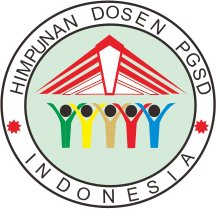The influence of emotional intelegence, self-efficacy, and altruism on teacher's competence in inclusion elementary school
Downloads
This study aimed to: (1) describe emotional intelligence, self-efficacy, altruism, and teachers' performance who teach in inclusion elementary schools of Karanganyar District, and (2) determine the effect of emotional intelligence, self-efficacy, and altruism on teachers competence who teach in inclusion elementary school of Karanganyar District. The research was quantitative research using the ex-post facto method. The results of the study show that: (1) teacher's emotional intelligence is at the medium category, while self-efficacy, altruism, and teachers competence who teach in inclusion elementary school of Karanganyar District are in high category; (2) there is a significant relationship between emotional intelligence with the teacher's competence, with a value of r = 0.560 (r > 0,244 ), there is a significant relationship between self-efficacy with teacher's competence with a value of r =0.535 ( r > 0.244), there is a significant relationship between altruism with the teacher's competence, with a value of r = 0.711 (r > 0.244 ) and there is a significant relationship between emotional intelligence, self-efficacy, and altruism with the teacher's competence, with a value of F = 39.742 (F > 2.76). Therefore, it concluded that higher emotional intelligence, and altruism the higher the teacher's competence.
Downloads
Abraham, R. (2004). Emotional competence as antecedent to performance: A contingency framework. Genetic, Social, and General Psychology Monographs, 130 (2), 117–143
An EFA Flagship. (2004). The rights to education for persons with disabilities: Towards inclusion, (Online), http://unesdoc.unesco.org/education_for_all_(efa_america)_inclusion.pdf . Diunduh 01 Desember 2014
Azwar, S. (2005). Penyusunan skala psikologi. Yogyakarta: Pustaka Pelajar.
Bandura, A. (1993). Perceived self-efficacy in cognitive development and functioning. Educational psychologist, 28(2), 117-148.
Bandura, A. (1994)."Self efficacy" In V.S. Ramachaudran (Ed). Encyclopedia of Human Behaviour, 4, 71-81. New York: Academic Press.
Bandura, A., Freeman, W. H., & Lightsey, R. (1999). Self-efficacy: The exercise of control. New York, NY.: Freeman
Batson, C. D., Batson, J. G., Slingsby, J. K., Harrell, K. L., Peekna, H. M., & Todd, R. M. (1991). Empathic joy and the empathy-altruism hypothesis. Journal of Personality and Social Psychology, 61(3), 413-426.
Boyatzis, R. E., Goleman, D., & Rhee, K. (2000). Clustering competence in emotional intelligence: Insights from the Emotional Competence Inventory (ECI). Handbook of emotional intelligence, 99(6), 343-362.
Berry, R. A. W. (2006). Inclusion, power, and community: Teachers and students interpret the language of community in an inclusion classroom. American Educational Research Journal, 43(3), 489-529.
Bell, B. S., & Kozlowski, W. J. (2002). Goal orientation and ability: Interactive effects on self-efficacy, performance, and knowledge. Journal of Applied Psychology, 87(3), 497-505.
Boehm, C. (1979). Some problems with altruism in the search for moral universals. Behavioral Science, 24(1), 15-24.
Broke, L., & Stone, D. (2005). Competency based on training. New York: McGraw-Hill Company.
Campbell, R. L. (2006). Reply to Robert H. Bass," egoism versus rights"(spring 2006): altruism in Auguste Comte and Ayn Rand. The Journal of Ayn Rand Studies, 357-369.
Ciarrochi, J., Forgas, J. P., & Mayer, J. D. (Eds.). (2001). Emotional intelligence in everyday life: A scientific inquiry. Psychology Press.
Cherian, J., & Jacob, J. (2013). Impact of self efficacy on motivation and performance of employees. International Journal of Business and Management, 8(14), 80.
Cipkin, G & Rizza, F. (2003). The attitude of teachers on inclusion. Retrived from http://www.nummarius.com/The_Attitude_of_Teachers_on_Inclusion.pdf.
Cochran, W. G. (2007). Sampling techniques. John Wiley & Sons.
Cooper, R. K., Sawaf, A., & Widodo, A. T. K. (1998). Executive EQ: kecerdesan emosional dalam kepemimpinan dan organisasi. Gramedia Pustaka Utama.
Departemen Pendidikan Nasional. (2005). Undang-Undang No.14 Tahun 2005 tentang guru dan dosen.
De Waal F.B.M. (2008). Putting the altruism back into altruism: The evolution of empathy. Annual Review of Psychology, 59, 279-300.
De Waal, F. B. (2008). Putting the altruism back into altruism: the evolution of empathy. Annu. Rev. Psychol., 59, 279-300.
Florida State University Center for Prevention and Early Intervention Policy. (2002). What is inclusion?. Retrived from http://www.pdfgeni.com/ref/what-is-inclusion-pdf.html.
Galis, S.A., & Tanner, C.K. (1995). Inclusion in elementary schools: A survey and policy analysis.Education Policy Analysis Archives, 3 (15).
Gintis, H., Bowles, S., Boyd, R., & Fehr, E. (2003). Explaining altruistic behavior in humans. Evolution and Human Behavior, 24(3), 153-172.
Goleman, D. (2000). Working with emotional intelligence: Kecerdasan emosi untuk mencapai puncak prestasi (cetakan ketiga).Terjemahan: Alex Tri K.W. Jakarta: Gramedia Pustaka Utama.
Goleman, D. (2004). Emotional intelligence. Terjemahan: T. Hermaya. Jakarta: PT Gramedia Pustaka Utama.
Harrison, A. W., Rainer Jr, R. K., Hochwarter, W. A., & Thompson, K. R. (1997). Testing the self-efficacy-performance linkage of social-cognitive theory. The Journal of Social Psychology, 137(1), 79-87.
Hastings, R. P., & Oakford, S. (2003). Student teachers' attitudes towards the inclusion of children with special needs. Educational psychology, 23(1), 87-94.
Singh, I., & Jha, A. (2012). Teacher effectiveness in relation to emotional intelligence among medical and engineering faculty members. Europe's Journal of Psychology, 8(4), 667-685.
Luszczynska, A., Gutiérrez"Doña, B., & Schwarzer, R. (2005). General self"efficacy in various domains of human functioning: Evidence from five countries. International Journal of Psychology, 40(2), 80-89.
Mayer, J.D., Salovey, P., & Caruso, D.R.(2000). Models of emotional intelligence. In J. Sternberg (Ed.), Handbook of intelligence (pp. 396-420). New York: Cambridge University Press.
Mcdougall & Kang. (2008). Memory self-efficacy and memory performance in older males. The University of Texas at Austin.
Yazid, M., & Jabar, C. (2013). Hubungan mutu guru, kepemimpinan kepala sekolah, dan status ekonomi guru dengan kinerja guru SD Kecamatan Suralaga Lombok Timur. Jurnal Prima Edukasia, 1(1), 94-102. doi:http://dx.doi.org/10.21831/jpe.v1i1.2326
Mulyasa, E. (2007). Menjadi guru profesional: Menciptakan pembelajaran kreaktif dan menyenangkan, Bandung: Remaja Rosdakarya.
Myer, D, G. (2012). Psikologi sosial. Terjemahan: Aliya Tusyani dkk. Jakarta: Salemba Humanika.
Nikki, B & Reid, B. (2013). Self efficacy belief and teacher effectiveness: Implications for professional development. Journal The Professional Educator, Vol.XXVI (1).
Patton, H. (2001). Emotional intelligence di tempat kerja. Terjemahan: Zaini Dahlan. Jakarta:Pustaka Delaprasa.
Penrose, A., Perry, C., & Ball, I. (2007). Emotional intelligence and teacher self efficacy: The contribution of teacher status and length of experience.Journal of Educational Psychology, Vol 17 (1), 100-125.
Phin, C. (2014). Teacher competence and teacher quality in cambodia's educational context linked to in-service teacher training: An examination based on a questionnaire survey. International Journal of Educational Administration and Policy Studies, 6(4), 62-69.
Presiden Republik Indonesia. (2005). Peraturan Pemerintah RI Nomor 19, Tahun 2005, tentang standar nasional pendidikan.
Ratcliff, O.Y.M. (2009). Voices of classroomsmanagers: Their realities of full inclusion. Electronic Journal for Inclusive Education, Vol. 2(4).
Republik Indonesia. (2003). Undang-Undang RI Nomor 20, Tahun 2003, tentang Sistem Pendidikan Nasional.
Sears, D. O., Freedman, J. L., Peplau, L. A., & Adryanto, M. (1994). Psikologi sosial. Jakarta: Erlangga.
Sesardic, N. (1999). Altruism. Brit J. Phil. Sci., 50, 457-466.
Shade, R. A., & Stewart, R. (2001). General education and special education pre-service teachers' attitudes toward inclusion. Professional Development Collection, Vol.46 (1), 264-273.
Shade, R. A., & Stewart, R. (2001) General Education and Special Education Preservice Teachers' Attitudes Toward Inclusion. Preventing School Failure: Alternative Education for Children and Youth, 46(1), 37-41, DOI: 10.1080/10459880109603342
Shapiro, L. E. (2003). Mengajarkan emotional intelligence pada anak. Jakarta: PT Gramedia Pustaka Utama.
Umar, H. (2008). Metode penelitian untuk skripsi dan tesis bisnis. Jakarta: PT RajaGrafindo Persada.
UNESCO. (1994). Penyataan salamanca dan kerangka aksi mengenai pendidikan kebutuhan khusus, (Online),http://www.idp-europe.org/indonesia/docs/SALAMANCA_indo.pdf, diunduh 02 Desember 2014.
The copyright of the received article shall be assigned to the journal as the publisher of the journal. The intended copyright includes the right to publish the article in various forms (including reprints). The journal maintains the publishing rights to the published articles.

Jurnal Prima Edukasia by http://journal.uny.ac.id/index.php/jpe/index is licensed under a Creative Commons Attribution-ShareAlike 4.0 International License.


























